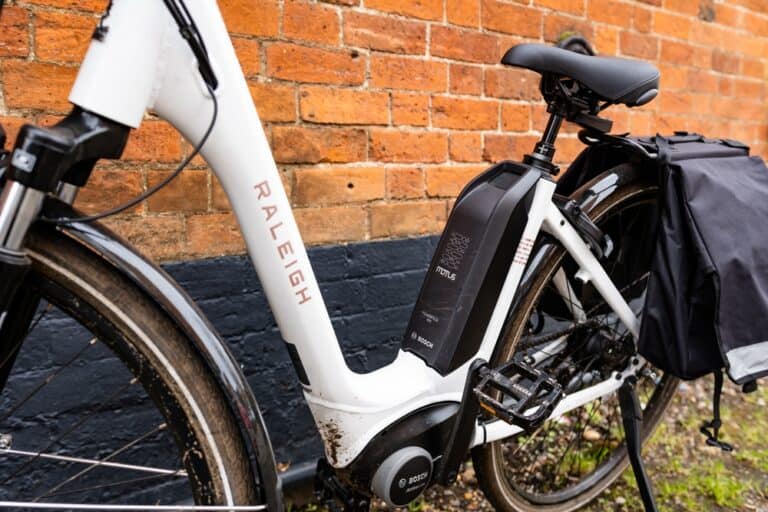Do Racing Bikes Have Brakes?

There are so many different types of bikes with various setups and configurations that it leads to some confusion for cyclists and non-cyclists alike. Among the biggest questions regarding road racing bikes is whether or not these bikes have brakes, as some races claim to use no brakes, while others state that brakes are critical for racing bikes.
Road racing bikes do have brakes, but track racing bikes do not. Road racing bikes need brakes to account for various terrain conditions and unforeseen hazards. Track racing bikes face no hazards or uneven terrain and are therefore equipped to simply slow their wheels by pedaling backwards.
Unraveling this confusion is critical to bring answers regarding the brakes used on racing bikes, and there are many misconceptions that need to be undone and many truths that need to be highlighted. Let’s explore racing bike brakes and find out where this confusion comes from.
Do Racing Bicycles Have Brakes?
When answering this controversial and confusing question, there are some important distinctions to make regarding racing bicycles. These distinctions are important because some racing bikes have brakes, and others do not.
Racing bicycles that are used for the road, also known as road racing bikes, are equipped with brakes. These bikes are required to have brakes to enable them to handle any situation that the road may present.
These bikes have to handle slopes, hills, sharp curves and bends, road angles, and hazards such as potholes, and they have other bikes to avoid as well.
Road racing bikes must have brakes to keep the rider, their bike, and other road users safe.
However, there is a type of racing bike that does not use brakes at all.
Track racing bikes or velodrome bikes do not have brakes. These bikes are dangerous for their riders and the other riders on the track if they have brakes, and as a regulations standard, they are therefore not equipped with them.
Here lies the confusion.
The reality is that some racing bikes have brakes, and others do not. This is why so many people are confused about whether or not these bikes have brakes.
Velodrome bikes and road racers are very different machines, and they have drastically different requirements.
If you look at these bikes side by side and understand the conditions and surfaces in which they are used, you will clearly see that road racers need brakes, while track racers do not.
What Brakes Do Racing Bikes Use?
Road racing bicycles do use brakes for the sake of safety and bike control. There is a wide range of racing bike setups and configurations that require the use of different types of brakes.
Bikes made for road racing come in many different varieties, but the types of brakes used for these bikes are usually determined by the frame and the size of the wheels that the frame can accommodate.
Racing bikes with very narrow forks that are designed to accommodate the thinnest wheels and tires are usually designed to use rim brakes, as there is not enough rood within the when assembly for disc brakes.
However, disc brakes are far more effective than rim brakes, so some road racers opt to use bikes that can accommodate slightly wider wheels for the sake of using disc brakes.
Modern disc brake mechanisms are very thin and can be used on relatively thin wheels, but the thinnest of all is still too thin for discs.
The brakes that a racing bike is equipped with are based on the preferences of the rider, the type of roads the bike is used on, the speeds that the bike is made to achieve, and the confidence the rider has on the road.

Why Are Brakes Unnecessary For Some Racing Bikes?
If some racing bikes need brakes to keep the rider safe, why do others not need to use brakes at all?
Racing bikes that are used on the track or in velodromes do not require brakes because the nature of the track does not require them, and the bikes themselves are equipped with specialized mechanisms that allow the riders to slow the wheels by pedaling backwards.
The speeds that these bikes do during a race, combined with the slick wooden floors that they race on, means that suddenly applying brakes would result in a catastrophic accident that may harm the rider and the other racers on the track.
The way these bikes race does not call for brakes either, as they never need to slow down unless they are stopping. There are no obstacles to doge; every rider stays in their own lane, and there are no bumps on the road or sudden curves or corners.
These bikes never need to brake suddenly, and when they do need to slow down, the riders simply slow the wheels by changing the rotation of their pedals.
Velodrome racing bikes have no need for brakes, and the application of brakes to these bikes would make velodrome racing far more dangerous.
Are Racing Bike Brakes Effective?
Everything on a racing bike is made to be as lightweight as possible. This leads some cyclists to wonder how effective the braking systems on road racers are in comparison to other bikes and how well they work when required.
Road racing bikes are far lighter than regular road bikes and other bicycles, such as mountain bikes, which means that the braking systems on these bikes do not need to be as powerful as those of other bike types.
The fact that the brakes on these bikes do not need to b particularly strong to be effective means they can be lighter and less heavy-duty than other braking systems.
This is why the brakes on racing bikes seem to be so much smaller than the brakes of other bikes, but they are still as effective as other braking systems.
Conclusion
Racing bikes are equipped with brakes if they are used for road racing, as these bikes need to be able to stop and slow down quickly in the event of a sudden terrain change or in the event of a hazard or emergency. Track racing bikes do not need brakes because they do not face these situations.
If you ever see a racing bike without brakes, it is either owned by a fearless road racer or the bike is intended for track racing where brakes are unnecessary altogether.






